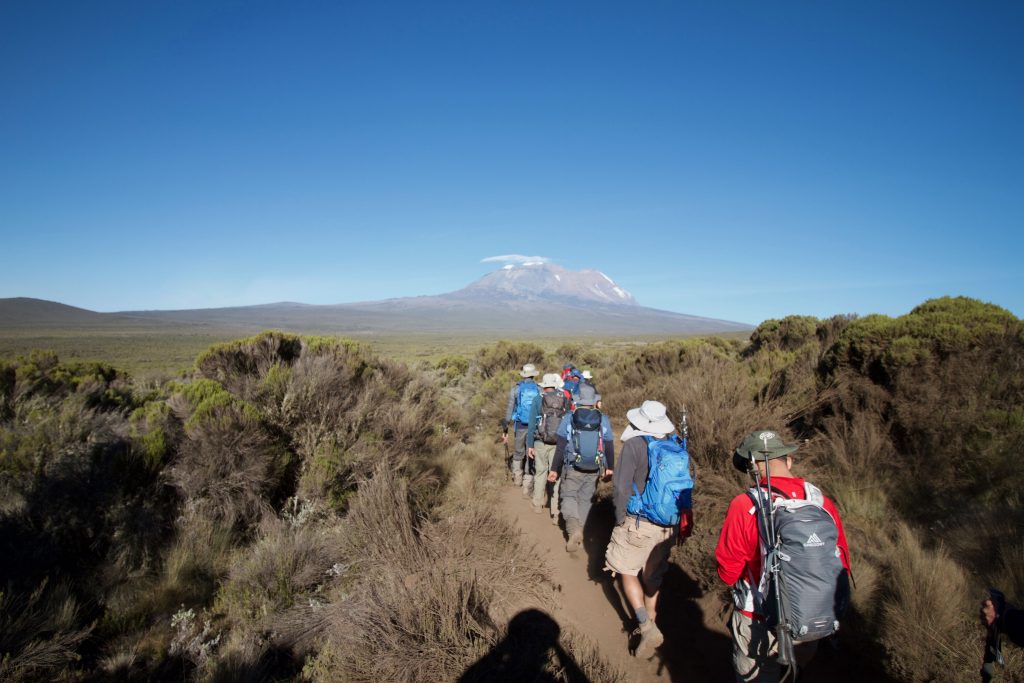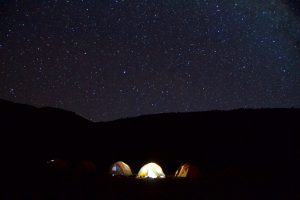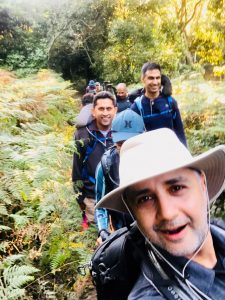How Climbing Kilimanjaro Made This Firm Leader an Even Better Lawyer
"Only when you get out of your comfort zone do you truly realize what your potential can be," says Nimish Patel, vice chairman at Mitchell Silberberg & Knupp in Los Angeles.
September 25, 2019 at 01:24 PM
6 minute read
 Patel and fellow climbers on the Lemosho route to Kilimanjaro. Courtesy photo.
Patel and fellow climbers on the Lemosho route to Kilimanjaro. Courtesy photo.To celebrate his 50th birthday, Nimish Patel, vice chairman and partner at Mitchell Silberberg & Knupp in Los Angeles, successfully climbed Mount Kilimanjaro in Tanzania. During his adventure, Patel says he discovered ways to become a more effective firm leader and advocate for his clients.
Kilimanjaro is a dormant volcano containing three volcanic cones and stands over 19,318 feet, is the highest mountain in Africa and is the highest free-standing mountain in the world. Patel started his climb July 25 and returned safely Aug. 1.
How did you prepare for your climb? Since you really cannot train for altitude, you must be in good physical shape to be able to hike for eight to 10 hours a day. I work out on a regular basis, but I started doing a lot more cardio about one year ago to prepare for the climb. I increased my cardio by climbing eight to 10 sets of staircases once a week and taking spin classes three to four times a week. And, if I didn't have time to work out, I would walk up and down 20 flights of stairs in our office building, for one hour, during lunch.
 Courtesy photo – Tents under the stars.
Courtesy photo – Tents under the stars.Our climb schedule was six days climbing up the mountain and two days to coming down. Climbing up the mountain is difficult because of the thinning altitudes. Going down is faster because you are getting more acclimated to sea level and because of gravity, the body moves faster. But it's also harder on the legs and calves.
What did you learn about the climb that has helped you as a lawyer? I learned that only when you get out of your comfort zone do you truly realize what your potential can be. I discovered that I am a lot more resilient than I ever gave myself credit for and that I have the patience, endurance and the drive to think long-term and take on challenging goals. All of these new qualities I discovered about myself I hope to bring to my firm as a leader and to my clients as their zealous advocate.
What inspired you to climb Kilimanjaro? The Kilimanjaro climb is not considered a technical climb, so no ropes or ladders are needed. It's still a hard and rigorous climb, but it's safer. Kilimanjaro is one of the seven world peaks, and to say you climbed one of them is awesome. We took the Lemosho route (one of six routes) to the summit. We hiked through the jungle, desert and rocks to the peak. Every day we started our climb at 6:30 a.m. Then we took a break for lunch, rested for one hour, then climbed until just before dark. When it was time to sleep, we descended to a lower point, about 500 feet, to get our bodies used to the altitude.
My worst memory of the trip was having to pee constantly. Hydrating and drinking water is important, so I drank six to seven liters of water a day. At night, I would have to get out of my tent multiple times to pee. My best memory was seeing the stars and entire Milky Way at night. It takes your breath away. You can see forever and the curvature of the earth. It's something you never forget.
When we got to the summit, we spent the night at Crater Camp, which is about 500 feet into the crater area. The oxygen was 40% and it was minus 10 degrees. We were exhilarated that we summited, but it's at that moment that it's the harshest conditions for you. It's cold. You are at a high altitude and you are fatigued. When we reached base camp after coming down the mountain, the guides and porters formed a circle and sang a song in Swahili. The energy was high and everyone started dancing. All eight days of emotion was coming out of you. There is nothing like it.
Our porters were also a source of inspiration. The porters were in charge of making camp for us during our climb. They fed us, packed up our stuff and put about 60 pounds of our stuff (kitchen supplies, sleeping supplies and more) on their back. They would run ahead to prepare for our next camp. Half of the porters on our climb were women. We needed all their expertise to make the climb successful.
 Courtesy photo – Hiking Kilimanjaro.
Courtesy photo – Hiking Kilimanjaro.What is the most surprising thing that you realized about yourself? Your body tells you to stop at a certain point, but you realize that the human body is a lot more resilient than you think. The idea of hiking eight to 10 hours for eight days with altitude changes is not easy. I had never really trained for this climb, and I never thought that it was possible for me to accomplish the climb. I was wrong. It was possible. I took my body beyond what I thought was possible. I pushed past that mental barrier. Also, since I was completely off-line—no cell, emails or texts—I had the ability to recharge. I came back home more rested and invigorated. Psychologically, turning 50 seemed scary to me. I wanted to prove to myself that I capable of doing the climb. I was not mentally ready to do this in my 20s or 30s. I was taking on a challenge and checked off my bucket list item.
What was the most exciting part of the trip? The bonding part. You get to know your hike mates. You see people when they are at their lowest. And you also get to see the best of everyone. We got to share all these experiences together.
This content has been archived. It is available through our partners, LexisNexis® and Bloomberg Law.
To view this content, please continue to their sites.
Not a Lexis Subscriber?
Subscribe Now
Not a Bloomberg Law Subscriber?
Subscribe Now
NOT FOR REPRINT
© 2025 ALM Global, LLC, All Rights Reserved. Request academic re-use from www.copyright.com. All other uses, submit a request to asset-and-logo-licensing@alm.com. For more information visit Asset & Logo Licensing.
You Might Like
View All
How I Made Partner: 'Be Open With Partners About Your Strengths,' Says Ha Jin Lee of Sullivan & Cromwell

How I Made Partner: 'Avoid Getting Stuck in a Moment,' Says Federico Cuadra Del Carmen of Baker McKenzie

How I Made Partner: 'Find Your Niche and Become the Go-To Person,' Says Shawn Hendricks of Stradley Ronon Stevens & Young
Trending Stories
- 1Church of Scientology Set to Depose Phila. Attorney in Sexual Abuse Case
- 2An AG Just Specified How AI Could Get You in Hot Water
- 3Supreme Court Appears to Lean Toward Letting TikTok Ban Take Effect
- 4Standing Spat: Split 2nd Circuit Lets Challenge to Pfizer Diversity Program Proceed
- 5Judge Jablonski and Chief Justice Rabner Both Acted Completely Properly
Who Got The Work
Michael G. Bongiorno, Andrew Scott Dulberg and Elizabeth E. Driscoll from Wilmer Cutler Pickering Hale and Dorr have stepped in to represent Symbotic Inc., an A.I.-enabled technology platform that focuses on increasing supply chain efficiency, and other defendants in a pending shareholder derivative lawsuit. The case, filed Oct. 2 in Massachusetts District Court by the Brown Law Firm on behalf of Stephen Austen, accuses certain officers and directors of misleading investors in regard to Symbotic's potential for margin growth by failing to disclose that the company was not equipped to timely deploy its systems or manage expenses through project delays. The case, assigned to U.S. District Judge Nathaniel M. Gorton, is 1:24-cv-12522, Austen v. Cohen et al.
Who Got The Work
Edmund Polubinski and Marie Killmond of Davis Polk & Wardwell have entered appearances for data platform software development company MongoDB and other defendants in a pending shareholder derivative lawsuit. The action, filed Oct. 7 in New York Southern District Court by the Brown Law Firm, accuses the company's directors and/or officers of falsely expressing confidence in the company’s restructuring of its sales incentive plan and downplaying the severity of decreases in its upfront commitments. The case is 1:24-cv-07594, Roy v. Ittycheria et al.
Who Got The Work
Amy O. Bruchs and Kurt F. Ellison of Michael Best & Friedrich have entered appearances for Epic Systems Corp. in a pending employment discrimination lawsuit. The suit was filed Sept. 7 in Wisconsin Western District Court by Levine Eisberner LLC and Siri & Glimstad on behalf of a project manager who claims that he was wrongfully terminated after applying for a religious exemption to the defendant's COVID-19 vaccine mandate. The case, assigned to U.S. Magistrate Judge Anita Marie Boor, is 3:24-cv-00630, Secker, Nathan v. Epic Systems Corporation.
Who Got The Work
David X. Sullivan, Thomas J. Finn and Gregory A. Hall from McCarter & English have entered appearances for Sunrun Installation Services in a pending civil rights lawsuit. The complaint was filed Sept. 4 in Connecticut District Court by attorney Robert M. Berke on behalf of former employee George Edward Steins, who was arrested and charged with employing an unregistered home improvement salesperson. The complaint alleges that had Sunrun informed the Connecticut Department of Consumer Protection that the plaintiff's employment had ended in 2017 and that he no longer held Sunrun's home improvement contractor license, he would not have been hit with charges, which were dismissed in May 2024. The case, assigned to U.S. District Judge Jeffrey A. Meyer, is 3:24-cv-01423, Steins v. Sunrun, Inc. et al.
Who Got The Work
Greenberg Traurig shareholder Joshua L. Raskin has entered an appearance for boohoo.com UK Ltd. in a pending patent infringement lawsuit. The suit, filed Sept. 3 in Texas Eastern District Court by Rozier Hardt McDonough on behalf of Alto Dynamics, asserts five patents related to an online shopping platform. The case, assigned to U.S. District Judge Rodney Gilstrap, is 2:24-cv-00719, Alto Dynamics, LLC v. boohoo.com UK Limited.
Featured Firms
Law Offices of Gary Martin Hays & Associates, P.C.
(470) 294-1674
Law Offices of Mark E. Salomone
(857) 444-6468
Smith & Hassler
(713) 739-1250









